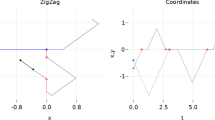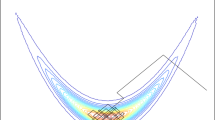Abstract
The unlinked random PSO model represented by the construction method shows the velocity anisotropy of the particle caused by the implementation method of random multiplicative parameters. On the other hand, another implementation method, the linked random method, is known to reduce the velocity anisotropy. First, we numerically analyze the parameter dependence of both the linked and unlinked random PSO models and find that the linked random PSO model shows a high global search ability and the unlinked random PSO model shows a high local search ability. Thus, a hybrid model of the linked and unlinked random PSO models is proposed by use of parameters obtained by our numerical parameter analysis of both models. As a result, the hybrid model has a high search ability for both unimodal and multimodal functions, especially rotated functions. Therefore, it is found that the local search ability and the global search ability are well balanced in the hybrid model.





Similar content being viewed by others
References
Kennedy J, Eberhart RC (1995) Particle swarm optimization. In: International conference on neural networks, IEEE, pp 1942–1948
Shi Y, Eberhart RC (1998) Parameter selection in particle swarm optimization, evolutional programming VII. In: Proceedings of EP 98, pp 591–600
Shi Y (2004) Particle swarm optimization. IEEE Connect 2:1
Schutte JF, Groenwold AA (2005) A study of global optimization using particle swarms. J Global Opt 31:93–108
Yang S, Sato Y (2017) Dynamic heterogeneous particle swarm optimization. In: IEICE transactions on information and systems E100-D, 2, pp 247–255
Clerc M, Kennedy J (2002) The particle swarm-explosion, stability, and convergence in a multidimensional complex space. IEEE Trans Evol Comput 6(1):58–73
Clerc M (2011) Standard particle swarm optimisation. http://hal.archives-ouvertes.fr/hal-00764996. Accessed 10 Apr 2019
Spears WM, Green DT, Spears DF (2010) Biases in particle swarm optimization. Int J Swarm Intell Res 1(2):34–57
Bigiarini MZ, Clerc M, Ro-jas R (2013) Standard particle swarm optimization 2011 at CEC-2013: a baseline for future PSO improvements. In: Proceedings of the IEEE, pp 2337–2344
Aiyoshi E, Yasuda K (2007) Metaheuristics and application. In: IEEJ, pp 69–90 (in Japanese)
Bonyadi MR, Michalewicz Z (2014) SPSO 2011: analysis of stability; local convergence; and rotation sensitivity. In: Proceedings of the 14th annual conference on Genetic and evolutionary computation, Vancouver, BC, Canada, pp 9–16
Author information
Authors and Affiliations
Corresponding author
Additional information
Publisher's Note
Springer Nature remains neutral with regard to jurisdictional claims in published maps and institutional affiliations.
About this article
Cite this article
Izumi, M., Iwai, T. Hybrid model of linked and unlinked random PSO models. Artif Life Robotics 25, 258–263 (2020). https://doi.org/10.1007/s10015-019-00577-3
Received:
Accepted:
Published:
Issue Date:
DOI: https://doi.org/10.1007/s10015-019-00577-3




